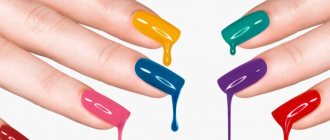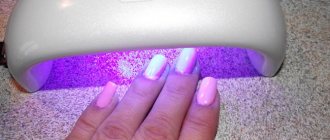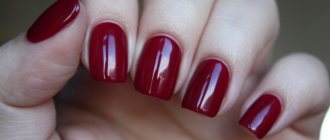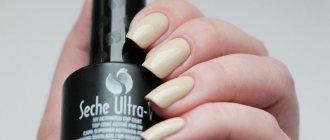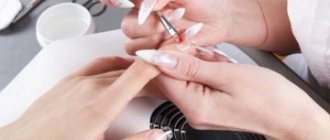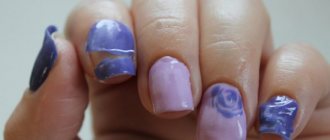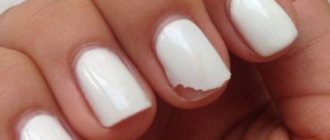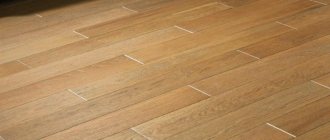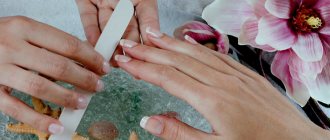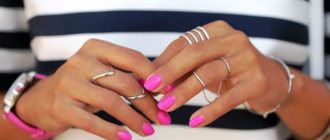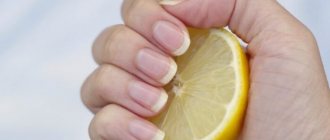Manicure with gel polish is not only covering the nail with a beautiful varnish or pattern, but also a technical process that requires skills and abilities. When working, manicurists face various problems. Including the fact that gel polish does not dry under a lamp.
Help: gel polishes are complex compositions, so drying them is a gradual transition of the composition from a liquid to a solid state. Therefore, it is more correct to say that gel polishes polymerize.
Manicure with gel polish always looks neat
Lamp dirty
Clean instruments are not only the calling card of the master and ensuring sterile conditions. A dirty lamp may cause the polymerization effect to weaken.
Therefore, it is necessary to wipe the lamp daily with the following liquids:
- Liquid for removing the sticky layer with medium dirt;
- Liquid for removing gel polish in case of increased contamination.
Liquid for removing sticky layer
LED – drying
In LED lamps, ultraviolet rays are produced by special semiconductor parts - LEDs. Semiconductors operate stably, for a long time, without switching off for up to 100 thousand hours, they are environmentally friendly. LEDs do not deteriorate due to frequent switching on and off, their temperature does not increase due to prolonged operation, and the radiation strength does not decrease. Even when one or two LEDs fail, the overall drying efficiency does not decrease.
Another positive feature of LED drying is the conversion of most of the energy into light rather than heat. Therefore, varnishes harden much faster and no ventilation is required for cooling. Without a fan, the device is smaller in size, price and weight than, for example, a UV device.
The peculiarity of LED dryers is that they produce short-wave light. Therefore, not all coatings harden equally quickly under their influence. Shellacs from recent years are set quickly, in a few seconds. But some take a very long time to harden, especially thick varnishes used to create artificial nails.
The lamp is not suitable for gel polish type
Most often, the type of drying lamp is indicated by a special marking on the varnish jar (UV for ultraviolet, LED for LED lamp). The latest generation of gel coatings produces varnishes that can polymerize in both types of lamps.
If the method of polymerization of the varnish is not indicated, then when purchasing a product you should ask the seller about this.
Important! In LED lamps, LEDs do not burn out and do not lose their power, therefore, if the selected coating does not require the use of a UV lamp, it is better to give preference to an LED lamp.
Manicure and gel polish
Just 8 years ago, no one had even heard of gel polish. With its appearance, the dream of many girls to have not only a beautiful but also long-lasting manicure has finally come true. Agree that not every representative of the fair sex has the opportunity to visit nail salons a couple of times a month. This is why many girls do their own manicure at home. A truly durable coating can only be achieved using gel polish. For its high-quality curing, a special lamp is required. In addition, the procedure for applying gel polish involves using a base and a “finish” on the nails. Each of these layers must also be polymerized (dried) in a UV or LED lamp.
The varnish has expired
Do not neglect the expiration date indicated at the bottom of the bottle or on the label. As a rule, the shelf life of varnish is from 1 to 3 years from the moment the bottle is opened.
Important! Often the varnish can simply stagnate or become thick if it is not used for a long time, which also makes it take a long time to dry. In this case, you should first check whether its expiration date has expired, and then “reanimate” it by rolling it in your palms. It is not recommended to shake this varnish.
All gel polishes have a limited shelf life
Terms of use
You may be interested in:Brigitte Bottier - new generation nail polishes
Modern craftsmen usually use hybrid lamps, which contain both ultraviolet and LED bulbs. Several years ago, UF lamps were used predominantly, with an average drying time of 2 minutes. LED technology allows you to significantly reduce the polymerization time, while still getting good results.
Modern equipment and materials for nail services, as a rule, require a short drying period, which ranges from 30 to 60 seconds.
But there are also emergency situations when the question arises as to why the gel polish does not dry in the lamp. There may be several reasons.
You may be interested in:Single-phase gel for nail extension: how to use? Technique for using single-phase gel
Improper storage of varnish
This product is especially sensitive to light, so for proper storage of gel polish you must follow the following rules:
- Always close the bottle of varnish to avoid the harmful effects of both UV lamps and sunlight. Exposure to light may cause changes in the structure of the product. This is why most manufacturers produce varnishes in dark bottles;
- Do a manicure in artificial light to protect the polish from the harmful effects of daylight;
- Store varnishes in dark places;
- Avoid temperature changes. Store the varnish in a place that guarantees a constant temperature of 26 degrees. If the temperature regime is violated, the life of the varnish is significantly reduced.
In addition, gel polish does not like shaking. When shaken, air bubbles form in the bottle, which cause poor surface quality.
Why do you need a lamp at all?
Simple varnishes dry perfectly on nails. Just sit quietly for 10 minutes and everything will be ready. Some masters advise placing nails painted with regular varnish under cold water to make drying faster. Tried it, it helps.
Modeling varnishes and gel varnishes are created using special high-molecular polymers. These substances are not capable of evaporation, so they do not dry in the usual way.
Even blowing a fan on your nails for an hour, or holding them over a warm radiator, will not produce a positive result. Shellac hardens only after its molecular structure changes. This is due to exposure to ultraviolet light.
Types of special devices.
UV, LED, CCFL devices are used to harden special varnishes. All dryers operate on the same principle. The result of their illumination is a change in molecules. Polymers are included in decorative products from which artificial nails are formed. The pattern of polymer molecules changes and the artificial nails harden. The main difference between the types of devices is the way the radiation is generated.
Incorrect nail treatment
Often masters violate the procedure for preparing the nail plate for manicure, which leads to the fact that the gel polish does not dry in the lamp.
The procedure for treating the nail is as follows:
- Treat your nails with a buff, which will create a rough surface for applying polish. Treating a nail with a polisher is a big mistake, since a too smooth surface of the nail plate prevents the uniform application of the varnish and, therefore, makes it difficult to polymerize;
- Apply cuticle oil after applying nail polish. Gel polish requires a dry and slightly rough surface. Cuticle oil makes the nail greasy, which creates an extra layer between the polish and the nail.
Why gel polish does not dry in a lamp: errors in technology
Most often, gel polish does not dry in the lamp due to improper manicure performance (improper positioning of the hand in the lamp, a thick layer of coating, residual stickiness, etc.), problems arise among newcomers to the nail industry, because the masters are well aware of the possible provoking factors.
The hand is positioned incorrectly in the lamp
If the gel polish does not dry completely in the lamp, then you should pay attention to the position of your hand - the best option would be to dry each nail separately, but this takes too much time. Professionals carry out the drying stage of each layer taking into account the following points:
- Dry only the thumb separately;
- It’s better to place everything else in a lamp in groups of 2;
- Nails are placed to dry in the center of the light fixture;
- All fingers (except the thumbs) can be placed simultaneously in the lamp to “dry”.
And you need to make sure that your fingers are positioned inside the lamp, tightly adhering to the hard surface - even a slight misalignment can cause the gel polish to slip and not dry enough.
Too thick layer of gel polish
Each layer of coating should be thin, and novice artists try to hide imperfections in the treatment of the nail plate with a thicker layer. If there is too much gel polish on the nail, even the most powerful lamp will not be able to dry such a layer. Professionals recommend not to rush, but to apply 3-4 layers and dry each thoroughly.
An example of correct application of gel polish
Residual sticky layer
Often, beginning craftsmen complain that the top layer of gel polish, even after prolonged drying in a lamp, remains soft and pliable, although the overall polymerization of the decorative coating has taken place. This is how residual stickiness manifests itself - this phenomenon occurs often, and is corrected with a special liquid. But professionals warn that you need to use a cleaner for this manipulation, and not replace it with medical alcohol, acetone or nail polish remover.
If the general technology for performing a manicure with gel polish has been fully followed, but the top layer remains soft after drying, then you just need to moisten a cotton pad in a cleanser and wipe each nail plate - the coating will be perfect.
In addition to the reasons listed, you need to pay attention to the choice of gel polishes - there is an anti-rating for those that are difficult to dry in a lamp, even with the correct application of layers and ideal preliminary preparation of the nail plate.
Examples of bad varnishes
The most problematic gel polishes with regard to drying include:
- Noname made in China. Their popularity is due to their low cost, and even many buyers receive positive reviews about the quality of such products. But you need to understand that China produces counterfeits of well-known manufacturers and is unlikely to comply with technological processes during the manufacture of products. The result can be completely unpredictable; often the gel polish spreads, practically does not polymerize, and becomes covered with cracks.
- Gelish gel polish is a decorative coating from an American brand. In general, this material is famous for its high quality characteristics, but it also has disadvantages. For example, sometimes there are complaints from professionals that the first layer of this gel polish “curls” a little when drying, even if a branded base coat was previously applied.
And one more nuance regarding this brand of gel polish - the white color of the coating polymerizes very poorly, so you have to significantly increase the drying time in the lamp. It’s interesting that other shades of gel polishes “behave” absolutely adequately.
- Lianail is a well-known brand, its popularity at one time was simply incredible, because the quality-to-price ratio of gel polishes was simply ideal. Over time, complaints began to be received that when applying the next layer, the brush began to get dirty with the previous one, and the last one “stretched” behind the lint.
Even experienced craftsmen reported this, but a priori they could not disrupt the technology of drying gel polish in a lamp. Afterwards, professionals adapted to solve this problem by increasing the drying time of each decorative layer in the lamp.
- Ingarden - the range of gel polishes from this manufacturer is simply huge; the line always includes the most popular shades. But users often complain that when removing a sticky layer and applying a subsequent one, the previous one may shift. The solution to the problem is simple - you need to increase the drying time for each layer of decorative coating to 2 minutes. This, of course, prolongs the time of manicure, but it turns out to be of very high quality.
- Bluesky is a well-known brand, but with one caveat: light shades take much longer to dry than dark ones. In general, it is believed that the materials from this manufacturer will be easiest to use for professionals who can properly dry gel polish in a lamp with ultraviolet light.
Wrong varnish
Today, the Internet is replete with offers from various brands of gel polishes in different price categories. In this variety, it is easy to make a mistake and buy a poor quality gel polish base that does not dry even if all the rules are strictly followed. Therefore, before choosing gel polish, you should carefully study customer reviews of the product, as well as the reputation of the manufacturer itself.
You should also not skimp on materials and tools for manicure. When choosing them, it is best to rely on the quality of the product. Good quality materials make the master’s work easier, and compliance with the above conditions not only improves polymerization, but also guarantees a longer manicure.
Why does gel polish chip off at the ends?
Quite often, customers complain about chipping of the coating in the end zone. It looks sloppy and the manicure has to be redone from scratch. There may be several reasons. The main one is the individual characteristics of the plate. The material does not adhere well to soft and flexible nails - ideally, it will take a maximum of two weeks until it starts to chip. In this case, the best option is acrylic or gel extensions. Cracks can also form due to improper treatment of the nail plate at the stage of hygienic manicure. The master must remove all irregularities with a file and apply the base to the buffed surface. When applying the coating, be sure to seal the ends, and only then place your nails in the lamp.
